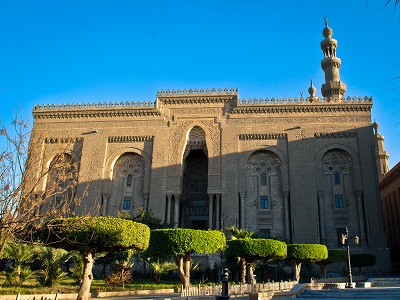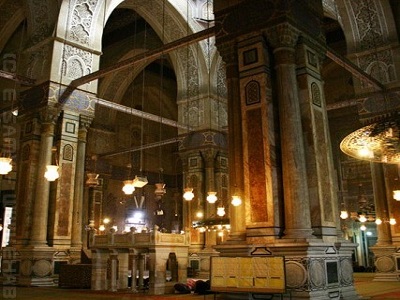Cairo’s
Famous Mosques
Mosque of Al-Aqmar
Al-Aqmar mosque is located on Al‑Mo’ez Street,
and was commissioned by the Fatimid Caliph Al‑ Amir Bi‑Ahkam Allah in 519 AH /
1125 AD. The mosque’s construction was supervised by the Vizier Al‑Ma’mun Al‑Bata’ihi,
and it was renewed during the reign of Sultan Barquq in 799 AH/1397 AD under
the supervision of the governor Yalbugha al‑Salmi.
The main façade of the mosque is presently the oldest surviving
stone façade. Its architecture is characterized by its intricate stone carvings
and the repetition of the phrase “Muhammad and Ali”, in addition to Qur’anic
verses written in the Kufic script. The engineer’s ingenuity is most manifest
in his ability to orient the façade to the street, whilst maintaining the
direction of prayer inside the mosque.
The mosque consists of an open courtyard at its
center surrounded by four riwaqs (arcades) topped by shallow domes, the largest
of which marks the qibla, the direction of prayer. An inscription above the
mihrab (niche in the wall of a mosque marking the qibla) records the
renovations that were undertaken by Yalbugha Al‑Salmi.
Located in Salah El‑Din Square (or Maydan Al‑Qal’a
“Citadel Square”), Al‑Rifa’i Mosque was built in the nineteenth century to
complement its fourteenth‑century neighbor, the mosque of Al‑Sultan Hasan. It
is a monumental structure that dwarfs the surrounding landscape. The mosque
gets its name from Imam Ahmad al‑Rifa’i (512–578 AH/1118–1181/2 AD), who
founded the Rifa’i tariqa (Sufi path).
The original structure was a Fatimid mosque,
which was then transformed into a shrine for Ali Abu Sheibak. Finally, Ottoman
queen Kosheir Hanim commissioned the current design of the mosque and put in
charge of the construction the architect Hussein Pasha Fahmi. Part of the plan
was to have a mausoleum for the royal family as part of the extension, which
was made by imported building materials from Europe, such as Italian marble. In
addition to traditional raw materials, cement has also been employed in the
construction of the mosque—a first for any Islamic monument in Egypt—signaling
the transition into modern times.
Al‑Rifa’i Mosque’s architectural design is as interesting as its
construction history. Visitors stand in awe of the detailed decoration of the
outer walls and massive columns of the outer gate. The minarets are
distinguished by their beauty and elegance.
While a section of the mosque is dedicated to prayers, another is
reserved for the members of the family of Muhammad Ali Pasha, which was in
power from the early nineteenth century until the 1952 revolution, when the
modern Egyptian republic was born. Khedive Ismail and his mother koshiyar
Qadin, as well as Kings Fuad I and Faruq, the last two rulers of the Muhammad
Ali Dynasty, are buried here, all enshrined in elaborate tombs. The mosque
briefly also served as the burial place of Reza Shah (king) of Iran (1363
AH/1944 AD), but he was returned to his home country following the end of World
War II. Part of his burial chamber, however, is occupied by his son, Mohammad
Reza Pahlavi (d. 1400 AH/1980 AD), the last Shah of Iran.


The Mosque and Madrasa of Sultan Hasan is one of
the largest and architecturally exquisite mosques in all of Egypt. It was
commissioned by the Mamluk sultan Hasan ibn Al‑Nasir Muhammad ibn Qalawun
sometime between 757 AH/1356 AD and 764 AH/1363 AD, and is located at the end
of Muhammad Ali Street, opposite its nineteenth century neighbor al‑Rifa’i
mosque in Al‑Qalaa.
Its proximity to the citadel ultimately resulted in its use as a
fort by enemies several times throughout its history. Some sultans seriously
considered demolishing it because enemy armies would use the mosques high
platforms to launch attacks on the citadel.
Like most Islamic monuments in Cairo, this one has also undergone
several phases of reconstruction, up until the twentieth century. The interior
and exterior domes of the mosque are extremely ornate, and their designs may
have been inspired by Armenian art and architecture.
A monumental iwan opens up on each of the four sides of the
interior square courtyard. An iwan is a vaulted rectangular space that is open
on one side. Doorways at the four corners of the courtyard allow access into
four madrasas, educational institutions, where the four Sunni Islamic schools
were taught.
Sultan Hasan Mosque on Google Maps
Al‑Hakim bi‑Amr Allah Mosque
The Mosque of al‑Hakim bi‑Amr Allah is the
fourth oldest mosque in Egypt, and the second largest after the Mosque of ibn
Tulun. The construction of the mosque was begun by al‑Hakim’s father, the
Fatimid Caliph Al‑Aziz bi‑Allah in 379 AH/989 AD, but he died before its
completion, leaving his son to finish it in 403 AH/1013 AD. The mosque is
located at the end of al‑Mo’ez Street in Al-Gammalia district, between Bab al‑Futuh
and Bab al‑Nasr.
The main entrance lies on the western side of the mosque, and is
monumental in size and design. It is one of the oldest architectural examples
of projecting stone porches, and was influenced by the great Mosque of Mahdiya
in Tunis. The mosque once served as a Shiite center in Egypt, and is comparable
to the role Al‑Azhar Mosque would later play for Sunni Islam.
The mosque has a long and intriguing history, including its role
as a barracks during the French campaign, when its minarets were utilized as
watch-towers. Originally, the mosque was constructed as an enclosure by the
Fatimid Vizier Gawhar Al‑Siqilli (382 AH/992 AD), and was later incorporated
into the fortifications built by the general Badr Al‑Gamali (d. 487 AH/1094
AD). The plan of the mosque consists of an irregular triangle with four arcades
centering a courtyard. Two minarets flank either side of the façade, and they
have undergone several restoration phases throughout their lifetime.
Al-Hussein Mosque is the
closest to the hearts of Egyptians and Muslims all over the world. For
Egyptians, Al-Hussein district is not only a residential district but also a
spiritual and historical one for housing Al-Hussein Mosque. Al-Hussein or
Sayyidna Al-Hussein was the grandson of Prophet Mohammad peace and prayer be
upon him and each year Egyptians hold a ceremony to celebrate his birth in
Al-Hussein district.
The Mosque was built during the Fatimid reign
and it has three white-marble doors overlooking Khan El-Khalili area and
another door next to the mosque’s dome known as the green door.
Mosque History
When first
established, the mosque was a shrine built by El-Saleh Talai from stone. It had
three doors, two minarets, and a dome on top of the mausoleum. It is
believed that head of Imam Al-Hussein, grandson of Prophet Mohammad, is buried
at the mosque.
During the Ayyubid era, Salah El-Din took care of the mosque and
built a madrassa to teach the four Sunni schools of Islamic jurisprudence. He
also expanded the mosque and the shrine inside it without its original
structure after it was burned because of the candles lit by the mosque's
visitors. Then Amir Abdel Rahman Katkhuda rebuilt the mosque adding two iwans
and a water fountain.
When Khedive Ismail ruled Egypt, he ordered to restore and expand
the mosque, which took ten years to complete. Then in 1953, the Egyptian
government expanded the mosque to be on a total area of 3340 m2. It established
an administrative building, a library at the eastern side along the mosque’s
dome, and a women’s prayer area.
In the first year of the eighties of the 20th century, the
Egyptian Antiquities Authority restored the holy shrine and the mosque.
Al-Hussein
Mosque has a prophetic monuments hall built by Khedive Abbas Helmi II in 18963,
Imam Al-Hussein’s shrine, and the world’s biggest chandelier.
Al-Hussein Mosque on Google Maps
The mosque is located at the beginning of Haret
Housh Qadm on El-Mo’ez Street. It was built by El-Khalifa El-Zafer Bi-Nasr
Allah Abu Mansour Ismail in 543 AH and 1148 AD. In the early 15th century, Amir
Yashbak Ben Mahdy decorated the mosque and demolished all buildings blocking
the view.
The mosque has two entrances leading to the
mosque’s courtyard covered with a decorated ceiling and a minbar in the middle,
which is surrounded by four iwans. The four iwans are characterized by its
simple structure without any inscription or marble skirting.
The
Mosque, Sabil, and Kuttab of Suliman Agha El-Silehdar is the jewel of El-Mo’ez
Street and it is one the most unique and magnificent Islamic monuments in Cairo
The
mosque is located on El-Mo’ez Street and it was built by Prince Suliman Agha
El-Silehdar in the ottoman style. It is divided into three riwaqs (arcades) and
attached to it a sabil, a kuttab, and several rooms.
The main
façade of the buildings which overlook El-Mo’ez Street includes the facades of
the mosque, madrassa, and Sabil, which all built of stone, while the sabil
façade covered with white marble and inscriptions. In the entrance, there is a
staircase leads to the mosque’s courtyard which is surrounded by four arcades
(riwaqs) supported by marble columns.
The
mosque is famous for its pencil-like minaret, and it is full of wooden
decorations combining oriental and western features.
Suliman Agha Mosque
on Google Maps
A vow to
Allah, this is the reason why Sultan Al-Muayyad established this grand museum
on Al-Mo’ez Street in 818 A.H and 1415 AD. It took 5 years to finish the
establishment of the mosque. Al-Sultan Al-Muayyad was one of Al-Zaher
Barquq’s mamluks before he ruled Egypt.
The Mosque’s Description
Al-Muayyad
Mosque is one of Cairo’s largest mosques and an architectural masterpiece. The
entrance of the mosque belonged to the Madrassa of Sultan Hassan, and Al-Sultan
Al-Muayyad bought it along with a copper furnace and attached it to the mosque.
After the entrance, there is Sultan Al-Muayyad’s mausoleum and next to it the
mausoleum of his son Ibrahim, who died at a young age. On the left, there is a
Sabil, built for visitors of the mosque and passersby.
The
mosque consists of an open courtyard surrounded by 4 arcades (riwaqs), the
tallest and biggest of which is the one toward al-qibla whose wall is covered
with colored marble.
The
mosque has two minarets built on top of the two towers of Bab Zuweila. Each has
three decorated and inscribed levels. The mosque also has four facades, the
main entrance of the mosque is on the eastern façade and has a double staircase
and a tall door covered with marble.
As for
the mosque’s dome, it is built from stone and has a marble floor. The dome has
two tombs of Sultan Al-Muayyad and his son.
Al-Azhar Mosque is one of the most ancient
mosques built in Egypt for more than a thousand years, during which it became
one of the world’s leading Islamic universities. In recognition of its
significant role as a beacon of moderate Islam, Al-Azhar Mosque is featured on
the Egyptian 50 piasters banknote.
Al-Azhar Mosque History
Al-Azhar Mosque was the first mosque
constructed in Cairo by the Fatimid Leader Jawhar El-Siqilli by order of the
Fatimid Caliph El-Moez Le Din Allah. Leader Jawhar El-Siqilli began its
establishment in 359 AH- 970 AD and was completed in 361 AH- 972 AD.
The mosque was built to be a
congregational mosque, similar to the Amr ibn Al-Aas Mosque in the Fustat area.
Additionally, it meant to be an institute for teaching Shi’ism. However, when
Salah El-Din assumed power, he prohibited prayers at the mosque because he was
a Sunni, and it remained so until the end of Ayyubid era. During the Mamluk
era, Al-Azhar Mosque flourished once again as Mamluk sultans and rulers raced
to develop and upgrade the mosque and support
its students and scholars and eventually it became the Islamic world’s most
renowned mosque and university.
Al-Azhar Mosque Name
Historians argued about
the origin of Al-Azhar Mosque’s name, and it is most likely that the Fatimid
named the mosque after the daughter of Prophet Mohammad “Peace and Prayers be
upon him” Fatima Al-Zahraa in honor of her memory.
The Mosque’s
Planning
Al-Azhar Mosque was
firstly built on half of its current area. Later, it underwent several
renovations, including expansions and constructions, until it reached its
current state.
The ground plan at the
time of its construction consisted of an open surrounded by three arcades, the
largest of which is the qibla arcade on the eastern side. The arcade
overlooking the courtyard is supported by piers, while the remaining arcades
are supported by marble columns. The western side of the courtyard was not originally
colonnaded, and in the middle of it was the main entrance.
Expansions of the
Azhar Mosque
The Fatimid Era
The Azhar Mosque
received the attention of the Fatimid. For 200 years, the mosque remained the
same without any additions to its structure. It only underwent some renovation
and redecoration. In 544 AH- 1149 AD, the Caliph El-Hafez Le Din Allah added an
arcade around all four sides of the courtyard. He also constructed a dome
decorated with Kufic inscriptions, one of the Fatimid’s most amazing inscriptions,
over the entrance to the corridor in the middle of the arcade adjacent to the
qibla arcade.
Al-Hafiz li Din Allah
undertook the construction of a dome over the entrance of the transept. It is
considered the oldest inscribed dome in Egypt and some of its carvings and
Kufic inscriptions are still preserved.
The Mamluk Era
Al-Madrasa
Al-Taybarsiyya (709 AH- 1309 AD): It was built by Prince Alaa El-Din Taybres, commander of the
armies during the reign of Sultan Al-Naser Mohammad ibn Qalawun, for Shi’a
scholars lessons. It is located on the mosque’s right-side entrance.
Al-Madrasa
Al-Aqbughawiyya: It was built by Amir
Alaa El-Din Aqbugha, supervisor of the royal kitchen and sultan’s food, on the
mosque’s left-side entrance.
Al-Madrasa Al-Gawhariyya:
It is located at the
northeastern of the mosque. It was built by Amir Gawhar Al-Qunquba’I, Khazandar of Sultan
Al-Ashraf Saif El-Din Barsbay, and it consists of four iwans centered by a
colored marble courtyard with Amir Gawhar mausoleum inside it.
In 873 AH- 1468 AD: Sultan Qaitbay ordered the demolition of the
main gate on the mosque's western side and built the current one, with a
three-tiered minaret to its right.
While in 915 AH- 1510
AD: Sultan Qanswa Al-Ghory ordered the construction of a double-headed
minaret for the mosque. Its second tier was cladded with tiles, and it had two
staircases between its first and second tiers so that those who ascended one
staircase could not see those on the other.
The Ottoman
Era
The
Azhar Mosque received
full attention from rulers and dignitaries of Egypt during this era, including
renovation and expansion works. The most important and largest of which was
carried out by Prince Abdel Rahman Katkhuda in 1167 AH- 1753 AD. He expanded
the mosque, adding arcades behind the mihrab called the "Abdul Rahman
Katkhuda Iwan."
Prince
Katkhuda made the iwan’s ceiling and floor higher than those of the mosque and
built a new mihrab and minbar. The new iwan had two gates. One was known as
“Bab Al-Sa’aida,” above which there was a Kuttab to teach the Quran to poor
people and next to it a minaret.
Moreover,
Prince Katkhuda built a mausoleum on the left side of that gate. The other gate
“Bab El-Shourba” was built on the eastern side, adjacent to a minaret.
In the
19th century, the mosque underwent several important reforms and renovations,
notably during the reign of Khedive Abbas Helmi II, who established the library
of Al-Azhar Al-Sharif inside Al-Madrasa Al-Aqbughawiyya.
In
1961, Al-Azhar University was officially established, along with other
colleges. Some of the most famous scholars associated with Al-Azhar include Ibn
Khaldun, Ibn Hagar Al-Asqalani, Al-Sakhawi, Ibn Taghribirdi, Al-Qalqashandi,
and others.
The
historical significance of Al-Azhar University throughout the history of
Islamic Egypt cannot be overlooked, along with the role of its scholars in the
educational, religious, and political movement against the French campaign and
the struggle against British occupation.
The
mosque still stands proudly to this day, with its towering minarets defying
time and its scholars’ stature reaching the sky, unyielding to aggressors,
unbowed to tyrants, steadfastly defending the truth as long as its walls and
minarets remain.
Al-Azhar
Mosque on Google Maps
Last Update: 2024


